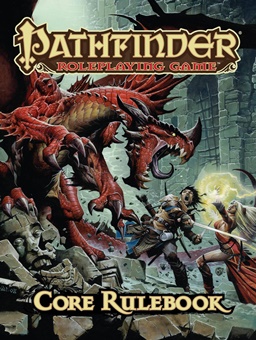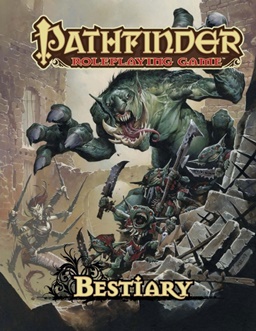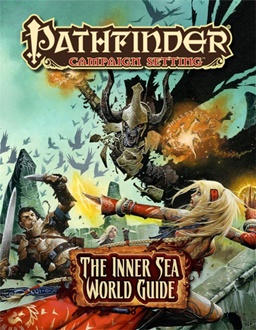Modular: Picking Pathfinder
I’m cur rently running a Swords & Wizardry (S&W) campaign for a few friends. I wrote here about why I chose S&W instead of my preferred system, Pathfinder. In fact, that post served as the genesis for this Black Gate feature, Modular. But now, I’m going to look at some of the strengths of Pathfinder and why, when this S&W campaign is done, I’m going to transition the group to a Pathfinder adventure.
rently running a Swords & Wizardry (S&W) campaign for a few friends. I wrote here about why I chose S&W instead of my preferred system, Pathfinder. In fact, that post served as the genesis for this Black Gate feature, Modular. But now, I’m going to look at some of the strengths of Pathfinder and why, when this S&W campaign is done, I’m going to transition the group to a Pathfinder adventure.
So, though I had both played and run Pathfinder, I chose S&W for reasons I talked about in that prior post. I wanted a more story-driven, less mechanics-based system. Also, because two-thirds of the party was new to pen and paper RPGing, I wanted something lighter in the rules department. And there’s no comparison between the two in that regard. The S&W Core Rules comes in at just over 140 pages. The Pathfinder Core Rulebook is almost 600!
Now, I explained in that first post that while I was still reading RPG products, I had stopped playing during 3rd Edition Dungeons & Dragons (D&D): there simply hadn’t been time for it.
But I wanted to get back into playing, and the choice seemed to be between Pathfinder and the newly released 4th Edition. Now, I had only ever played D&D, going back to 1st Edition. I mean, it was synonymous with role playing games and 4th Edition was the natural choice. But as I researched both systems, Pathfinder clearly seemed to be the way to go.
ACCESSIBILITY
Pathfinder is a very ‘easy to access’ system for both players and Game Masters. First, they’ve given you two options for obtaining the Core books: and one is dirt cheap!
When I had stopped playing, I don’t think digital copies were even around yet. Paizo, the company that owns Pathfinder, sold PDFs of their core books, for only $9.99. This let me check out the Core Rulebook for less than $10! THAT was a brilliant loss leader and made it easy for me to look at Pathfinder before 4th Edition.
 So, I downloaded the Core Rulebook, realized it was both the Dungeon Masters Guide and the Players Handbook in one and dug into the system. I was sold. I went ahead and bought hard copies of the Core Rulebook and Bestiary I (I’m a sucker for monster manuals!) and it was to be Pathfinder. I never did buy a 4th Edition product.
So, I downloaded the Core Rulebook, realized it was both the Dungeon Masters Guide and the Players Handbook in one and dug into the system. I was sold. I went ahead and bought hard copies of the Core Rulebook and Bestiary I (I’m a sucker for monster manuals!) and it was to be Pathfinder. I never did buy a 4th Edition product.
It would have cost me about twice as much to buy a Dungeon Masters Guide and Players Handbook for D&D. And really, even more, as I probably would have moved on when D&D dropped 4th Edition after only a few years.
Pathfinder clearly had a better system in place. And to this day, PDFs of the core books (there are over 20 and the line is still growing) can be purchased for $9.99. Try building a D&D collection on that price scale! Can’t be done.
Also, Paizo maintains, online, The Pathfinder Reference Document (PRD). The PRD contains the open rules from the Open Game License that the system is built on. Essentially, it’s all the information you need from all but the most recent Core books (and they do get added, not just immediately) to play. Classes, races, rules: Essentially, you can play Pathfinder without buying even one PDF book. Well, you might have to buy at least one module!
Now, the PRD does not have all of the AWESOME art that adorns their publications. The artwork in the Core books is another major selling point for Pathfinder. But you can use the PRD, for free, and play Pathfinder. For gamers on a really tight budget, it will work. I primarily buy PDFs, as my groaning bookshelves are begging for mercy. That gives me the best of both worlds: the art and layout of the paper books and the ability to access it digitally.
PLENTY OF MATERIAL
In addition to the Core books, Pathfinder has two supplemental lines: the Campaign Setting and Player Companion. The Campaign Setting books are geared more towards GMs than players and they provide both flavor and crunch. I love some of the history and nation information related to Golarion, the Pathfinder campaign world. The Player Companions usually offer additional options and rules for characters and expand the Core books. Want to play a vampire? Got it. Want to tailor your character to be an undead hunter? Got one for that, too. Though I don’t think those two should get together!
In addition, there are modules, Pathfinder Society adventures and six-installment Adventure Paths, linked adventures that let you take characters from 1st to 20th level. And there is a plethora of third party support for Pathfinder. So, your buying options are only limited to your budget!
Finally, the Paizo forums are a vibrant, thriving community and company employees are all over the place, interacting with fans. I’m not familiar with D&D forums, but from hearsay, Paizo is much more involved and facilitates more player input. Founder and CEO Lisa Stevens did a fascinating year-by year history of Paizo for that tenth anniversary that is a great read.
Add in Play by Post (free, online games through the forums) and that’s a pretty good look at why I chose and continue to play Pathfinder. Of course, accessibility and volume isn’t the whole picture.
OPTIONS OPTIONS! OPTIONS!
I went to the aforementioned PRD and a semi-thorough check yielded 37 character class options and 37 race options from the Core books. That does not include Prestige classes and class Archetypes, which significantly increase the class number. Also, there are more classes in the most recently released Core books, and I believe that the Campaign Chronicles and Player Companions add to the class, Prestige and Archetype counts as well. And that doesn’t even begin to address the Skills and Feats, which number in the hundreds and are the heart of tailoring your character.
While the simplicity of character creation in S&W reminds me of my early pre-Advanced Dungeons and Dragons days, customizing a character in Pathfinder is fun! I used to spend a half hour or more creating characters in Baldur’s Gate and Neverwinter Nights until I got just what I wanted for that particular play through. I like choosing options to get my specific build (I often favor Rangers with bows). Left to my own devices, I could happily spend an hour or more rolling up characters to choose from. Of course, the others at the table wouldn’t enjoy that.
RULES & MORE RULES

For me, the biggest difference between S&W and Pathfinder is the amount of rules. In that prior S&W post, I cited Matt Finch’s maxim, ‘Rulings, not Rules.’ In old school RPGing, the GM doesn’t rely primarily on the rulebook. They’re more guidelines. In my most recent S&W session, the party had just taken down three goblins. I decided at this point that one goblin, with two corpses next to him (including the leader), was going to break and run. Which gave the cleric he was facing an attack of opportunity, and she smashed his skull in. I didn’t roll for a morale failure check: I just made it happen.
In Pathfinder, you can find a rule for nearly every situation. When a gaming system passes a breaking point regarding how many rules have been added over the years, I refer to it as ‘rules bloat.’ With every supplement and Core book added, revenue goes up. But so do the number of rules and options. It seems likely that game balance is eventually lost under the sheer weight of so many rules.
But there’s something to be said for having rules to cover as many situations as possible. This creates a tacit understanding between the player and the GM and a level of expectation for that player. Notable exceptions will be pointed out (“no firearms in this campaign”) by a good GM. And there will be a few things that might arise. But the player can expect the rules of the system to be followed. They can turn to whatever rulebook it is and their character can act accordingly.
When Gary Gygax moved D&D from 1st Edition to AD&D, that’s the shift he was making. And it’s a shift away from the Original D&D, ‘make up any rule you want’ approach more attuned to Dave Arneson. And while I sometimes enjoy the ‘Rulings, not Rules’ approach, I like having the rules right there: assuming I can find them!
Gary Gygax talks a lot about rules construction and modification in his two books, Role Playing Mastery (for players) and Mastering the Game (for Game Masters). Both are worth seeking out for several reasons, but his rules-related discussion is certainly informative. A series of posts here at Modular will look at Gygax’ ‘Rules for (RPG Playing) Mastery.’
I’ve heard some good things about 5th Edition, which seems to have gone a long way in undoing the massive damage caused by 4th. Pathfinder certainly has a solid position as D&D moves back towards the top of the RPG mountain : a position it had held since actually creating the game.
Paizo has consistently said that there will not be a second edition. They’ve held firm, resisting the siren song of a new edition resulting in all new books for players to buy. So, they’ve continued building Pathfinder, leading to the inevitable rules and options bloat. This year they released Starfinder, a space RPG: presumably built on some version of the Pathfinder mechanics. Who knows? It might end up replacing Traveller!
Maybe one of my Modular cohorts will write a post on why they chose 5th Edition over Pathfinder!
Prior RPG-related posts I’ve done here at Black Gate:
RPGing is Storytelling
Dungeon Delving Tips – Part I
Dungeon Delving Tips – Part II
Swords & Wizardry vs. Pathfinder
Swords & Wizardry Kickstarter
Perilous Vistas from Frog God Games
The Lost Lands for Pathfinder
The Northlands Saga – Complete
The Warlords of the Accordlands
Judges Guild Premium Editions
Gary Gygax’s Role Playing Mastery
Everything You Ever Wanted to Know About the Temple of Elemental Evil
The Village of Hommlet
Munchkin!
Runebound
Runebound – The Sands of Al-Kalim
Runebound – The Mists of Zangara
Necromancer Games (Part One of two)
Frog God Games (Part Two of two)
Dungeons and Dragons Adventure Game System
D&D Adventure Game System – Temple of Elemental Evil
Dungeon! Board Game
Conan: Age of Exiles
Steve Russell of Rite Publishing – RIP
The Art of Dungeons & Dragons Kickstarter
Astonishing Swordsmen & Sorcerors of Hyperborea – 2nd Edition
Mount & Blade Warband – Part One
Mount & Blade Warband – Part Two
Bob Byrne’s ‘The Public Life of Sherlock Holmes’ column ran every Monday morning at Black Gate from March 10, 2014 through March 20, 2017. He also organized Black Gate’s award-nominated ‘Discovering Robert E. Howard’ series.
He is a member of the Praed Street Irregulars, founded www.SolarPons.com, the only website dedicated to the ‘Sherlock Holmes of Praed Street’ and blogs about Holmes and other mystery matters at Almost Holmes.
He has contributed stories to The MX Book of New Sherlock Holmes Stories – Parts III, IV and V and VI and will be in IX if he quits having fun writing Black Gate posts and works on a story!
I expected the name Conan to be randomly placed in several spots in your post.
I wrote this before the ‘Top 50 of August’ post came out. Drat!
I should have thrown in a line like, “It’s a shame the new CONAN RPG from Modiphius didn’t use the Pathfinder system.”
(Where’s that Edit button…?)
My son’s started GMing Starfinder. It’s great, but it’s not Traveller any more than Star Wars is The Martian.
There’s room for both, I think, and I can’t wait to play it…
I know nothing about RPG-ing, but I must say I sure like the covers on the Pathfinder adventures. I wonder who does the art work?
R.K. – I only just left out a comment on that very item. Wayne Reynolds does the most iconic stuff for Pathfinder. He’s done a lot of other RPG art, including for D&D. I think he’s great!
There’s a book out: ‘Visions of War: The Art of Wayne Reynolds.’ It’s got a ton of cool images.
I love Wayne Reynolds art. Before Pathfinder he did a lot of work on Eberron.
His material did a lot to shape the setting and its what i picture anytime i’m reading/playing in that world.
Don’t mess with any “Home Brew” nonsense with us, JD, we play only Offical HackMaster (TM) games!
I see Pathfinder as “What AD&D should have been” just as I see some good and ambitious Retro stuff, most notably Dungeon Crawl Classics and Labyrinth Lord to be what standard D&D should have been. And I’m by no means bashing those early games, this was the giant the modern ones stood on the shoulders of. The “Hackmaster” setting is legit, btw, both a merciless parody and loving tribute to classic D&D.
Pathfinder has by far the coolest art. Even decorated a notepad with a printout of the “Shark Pirate” pic:-) Still the high-gloss professional stuff creates a bit of distance from the original feel, which often had amateur then advanced amateur art creating a feel more accessable. This is an observation – if Pathfinder had sometimes good artists sporadically contribute to the illustrations – if DCC/Labyrinth Lord/etc bankrupted themselves five times over filling the retrograde games with high gloss AAA professional art – well both would be diminished by it – kind of a different business model and appeal. I lean towards the “Retro RPG” area in personal like, but won’t say anything bad on Pathfinder.
I’m really torn to what I’d start if I started an RPG campaign again. But too busy for such a time commitment right now.
Pathfinder if pretty much antithetical to my RPGing. As I learned back in AD&D 2e with its “Complete” books, the more unique options available for characters, the less unique characters felt. Give me a half-dozen players who can run identical-on-paper characters while making them all feel different, and I know I’m in the right group.
(D&D 4e was also antithetical to my RPGing, but it did look like a fun board game. 😉 )
Jeff – D&D 4th Edition rules translated well for the D&D Adventure Board games. Well, I liked them, anyways…